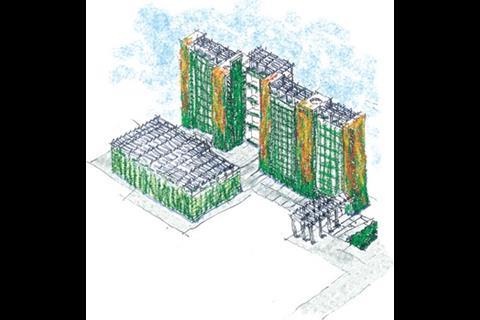Can smothering buildings in plants reduce air pollution, improve health and save the planet? A developer in Delhi is giving Battle McCarthy the chance to find out
Poor air quality is one of the most serious environmental problems in urban areas worldwide. A World Health Organisation assessment of health damage from exposure to high levels of particulates in 126 cities worldwide, where annual mean levels exceed 50mg/m3, reveals that this amounts to almost 130,000 premature deaths; over 500,000 new cases of chronic bronchitis; and many more lesser health effects each year.
A UK Met Office report suggests that by 2090, nearly a fifth of the world’s population will be exposed to well above the WHO’s recommended level of airborne pollutants.
Could covering cities in foliage be the answer? The ability of plants to process pollutants and produce oxygen has long been understood. By catching larger particulates in trees and shrubs, leaf absorption of gases and pollutant processing by root microbes and the roots themselves, plants rid the air of a multitude of nasties.
Green walls
Battle McCarthy is testing this theory to the full with its environmental design for an office project in India. The 163,000m2 Greenspaces development in Delhi includes four 20-storey office blocks that will be clad in creepers.
Atop each of the blocks will be a 15m high “plant house” air purifying system that will also clean the building’s grey water. Inside, vertical walls of planting will deal with pollutants created by the occupants.
“People are coming to understand the need to have vegetation in our cities and we are starting to see more green roofs being created,” says Chris McCarthy, director at Battle McCarthy.
“The trouble is, they don’t do much when it comes to absorbing pollution. We need to put the vegetation where the pollution is: in the streets, around the facades of buildings. The trouble with that is that people aren’t used to seeing buildings shrouded in plants, and architects aren’t always keen on seeing their work covered in greenery.”
Green roofs don’t do much when it comes to absorbing pollution. We need to put the vegetation where the pollution is: in the streets, around the facades of buildings
Another issue is that the rooftop plant house effectively gives over three storeys of potentially lettable space to the bio-air purification system.
McCarthy understands the problem: “If developers have to reduce their floor areas to introduce our plant house design they won’t do it. But, if we could get it written into legislation that the maximum height of a building would be the top floor of habitable space, with these plant houses above, they would be a real viable option for London and other major cities.”
Delhi’s Greenspaces project is funded by an Kamal Meattle, the CEO of Paharpur Business Centre (PBC), who is willing to test Battle McCarthy’s theories. The scheme design is complete and a guaranteed maximum price has been established. Detailed design is now under way and the project will start on site later this year.
Radical action needed
“We need radical solutions to improve our urban environment. We need more planting in cities to help dissipate pollution,” says McCarthy.
“In Toronto you have to allocate 30% of newly developed land to trees. In Seattle and Berlin they already count the vertical landscape as part of the environment and so covering a building in vegetation would go a long way to ensuring better air quality and meeting legislative requirements.
“We need to instigate these and other progressive obligations in the UK. Battle McCarthy isn’t the first to say this, we just want other people to get on board so we can make some headway with an issue as important as the air we breathe,” McCarthy says.
Greater London stands high in the world worst air quality stakes – in fact the European Commission recently announced it is taking action against the UK for its failure to meet agreed standards – so, Mayor Boris Johnson, please take note.
Downloads
Stage one
Other, Size 0 kbStage two
Other, Size 0 kbStage three
Other, Size 0 kb
Source
Building Sustainable Design

























1 Readers' comment